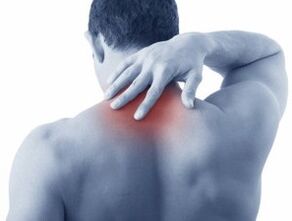
Osteochondrosis - Dystrophic changes in articular cartilage and bone tissue are more and more found.
Symptoms separated from osteochondrosis can also occur at 18 years old.This is explained by a sitting lifestyle.
The disease can affect any area of the spine, 52 varieties of osteochondosis are distinguished.
The first place belongs to the Lombo-Sacral, second place in terms of frequency of appearance belongs to cervical osteochondrosis (osteochondrosis of the cervical vertebrae).
Cervical osteochondosis - Characteristics, development stages
There are 4 steps of cervical osteochondosis, which have their own characteristics and symptoms.
- At the first stepCartilage is affected.A person suffering from 1st degree osteochondrosis feels a certain discomfort, a tension in the muscles, but nothing more.Symptoms at this stage are insignificant and do not cause a doctor a doctor.
- The second stepOsteochondosis is characterized by the beginning of the destruction of the fibrous ring, a decrease in light between the vertebrae, while it is possible to pinch the vertebrae and the appearance of unpleasant sensations.Second degree cervical osteochondosis is the most common.
- The third stepThe disease is characterized by the additional destruction of the intervertebral disc, the deformation of the vertebral bodies, the formation of bone processes, the appearance of a hernia (projection of a fibrous ring) is possible.
- At the fourth stadiumOsteochondosis is painful to move, the vertebrae are destroyed and strongly deformed.
Cervical osteochondosis is complicated by the sizes of small vertebrae.The junction of the occipital skull bone with the cervical vertebrae is pierced by nerve endings, blood and lymphatic vessels.
Characteristics of cervical osteochondosis.
- The mobile cervical region is articulated with a sedentary thoracic department.This increases the load on the vertebrae in the cervical region.
- The vertebrae of the vertebrae with cervical osteochondosis occur in the lateral direction.
- The vertebral artery, which passes through the side holes of 2-6 cervical vertebrae, is involved in destructive processes.
Symptoms and signs of cervical osteochondosis.

The frequent manifestations of cervical osteochondosis are headaches that occur at the back of the head and spread in the parietal and temporal region.During the exacerbation of the disease, the pain is so serious that it is difficult to turn or tilt your head.
The compression of the vertebral artery with cervical osteochondosis manifests itself by dizziness, flies that vacillate before the eyes.With a lively turn of the head, you can lose consciousness.The pain is given in their hands and shoulders.
The defeat of the vertebral artery is also manifested in the violation of coordination, hearing and vision.
When it has pinched the nerve in the vertebrae of the cervical region, the pain descends from the neck towards the scapula and through the hand to the fingers.The patient feels tingling, the appearance of goosebumps, the numbness of the fingers, the forearms, the brushes.The pain intensifies in the morning, gives the chest.
Damage to the vertebral artery manifests itself in pulsed pain in the head arches, the nape of the neck, the temples.Loss of consciousness, nausea, pain in the eyes, pain in the heart is possible.
The violation of the blood circulation can lead to a deterioration of memory and a decrease in intelligence.Painting pain in the heart looks like the symptoms of real angina.
The causes of the disease are a decrease in physical activity with the age of physical activity, the appearance of excess weight, hypothermia, violation of the congenital or acquired posture, injuries.
The disease can also affect people involved in heavy physical and office workers.



































